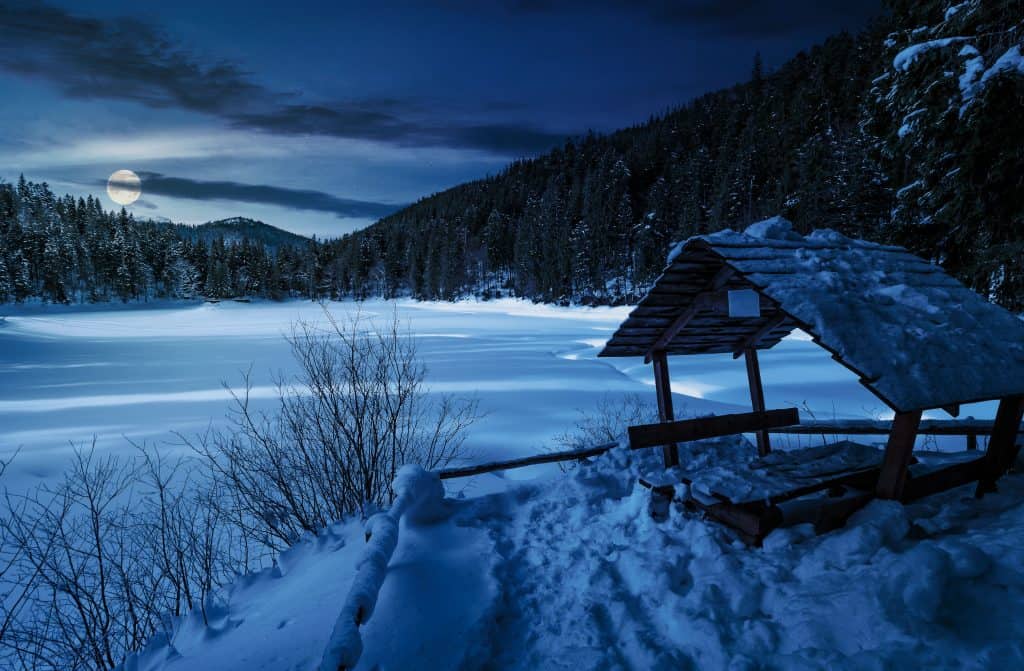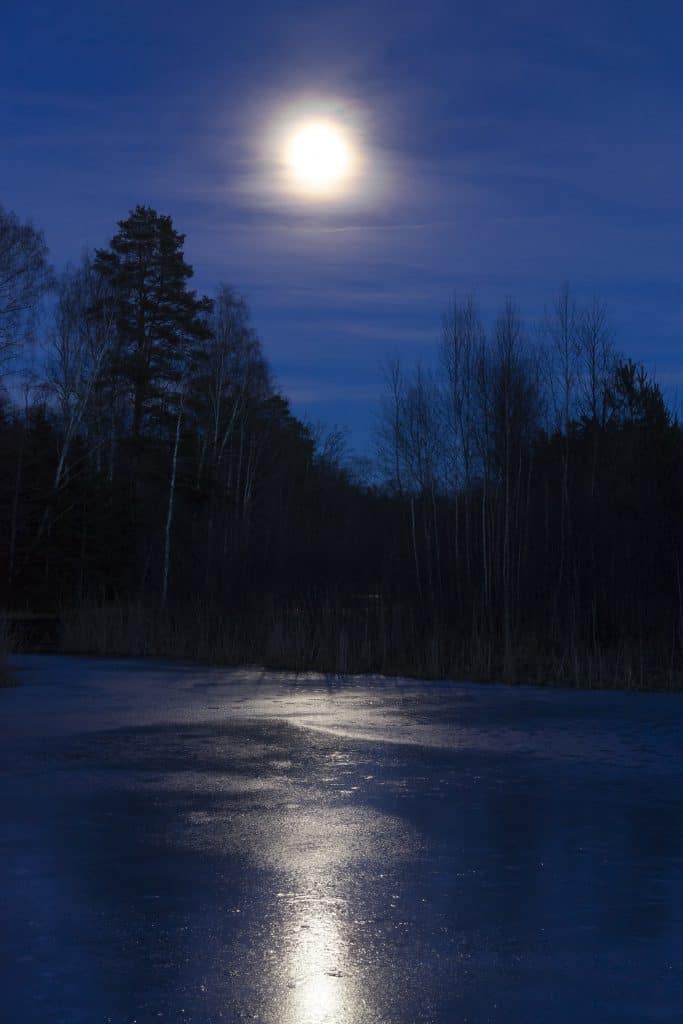Daylight hours in winter are short, and those planning to go ice fishing may wonder if they will have to pack up when the sun sets or if they can keep fishing in the dark. I am writing this blog post to answer that question.
Ice fishing at night absolutely does work. You can catch a lot of crappies at night, as in the winter they become more active at night. It is very common to catch walleyes as well. Other kinds of fish, like smelt, catfish, and trout may be found too, under certain conditions.
Ice fishing is a great way to spend winter evenings. There are things to be aware of before going, though, as it is a little different from fishing in the day.

Pros and Cons of Ice Fishing At Night
Pro: Extra Fishing Time
If you’re asking about ice fishing at night, it might be because you’re finding it hard to have time to go fishing during the day. After all, weekends might be the only daylight time you get to go fishing, but you have a lot of other things going on too then that stop you from going.
For that reason, the great benefit of ice fishing at night is the possibility of going any day of the week. So many more hours become open for you to spend on the lake. Wouldn’t it be nice to catch some fish after a long day of work?
Pro: Less Crowds
Another benefit of going at night is that the crowds that can sometimes fill frozen lakes in the daytime will be vastly reduced at night. You might have the lake almost all to yourself. Not only is it nice to have some peace and quiet, but you’ll have no competition for the best spots.
Pro: Catching Those Nocturnal Fish
Crappies actually become very nocturnal during the coldest months, so ice fishing at night is the perfect way to capitalize on that. In fact, you might not catch many of them if you don’t stay out after dark.
Walleyes are another species you will be able to find in the dark. They are a species that uses their low-light vision to get an advantage over their prey.
These fish swim around at night looking for food. Because of that, you can take a relaxed approach to fishing, if you want, and simply let these fish come to you, making nighttime ice fishing a great time to just sit around talking to friends.
Con: Less Variety of Fish
However, the big downside of fishing at night is that there are many species that are not so active then. Species other than crappies and walleyes can be caught, but it’s simply not as likely. Again, though, “less likely” doesn’t mean “impossible,” so it’s worth a shot.
Ask locals about what to expect, since conditions vary by area. They might know whether you’re likely to find fish such as smelt, catfish, or trout.
Con: Extra Danger
Safety is a bit of a concern at night, too, because there may be people riding around on different vehicles at high speeds who might not see you. Take simple measures to prevent this, though, and you will be fine.
Overall, ice fishing at night has a lot of benefits that make it worthwhile. It is true that you are less likely to catch certain species of fish, but you are very likely to catch crappies and walleyes, and you could always have luck on your side and wind up with other species too.
Tips for Finding Fish
If you go ice fishing at night, you should take the time first to pick a spot in the daytime. That may mean just getting to the lake well before it gets dark, putting lines in the water and staying well into the night. Or, you could do some daytime fishing one day and come back at night another time.
If a spot is not very productive in the daytime, it is not likely to be much better at night. Keep that in mind when deciding where to try fishing.
If you have a fish finder device, you will be easily able to read the shape of the land and find an ideal spot for fish to gather. This is even more true if you have a device with a GPS and detailed topographical maps. The more time you spend fishing, the more you will probably want one of these devices since they can make finding fish so much easier.
What type of areas should you be looking for? There is no one guaranteed kind of spot to catch fish, of course, but fishing experts often recommend offshore humps, bars, reefs, and main-lake points.
A particular area to focus on is the shallow “top” of a drop-off. Fish near the spot where the weeds stop growing.
If you have a successful spot where you fish deep during the day, try going to that same spot, but keeping your line in a shallower section of the water.
If you are fishing at an area with a lot of weeds, make sure to position your bait above the weeds. The fish won’t swim through them, but they will go above them.
Often, fish will move in groups, so if you catch one, you should move quickly to prepare more bait to catch another. Once the group passes by, you will experience a lull in the action, so be patient during that time.
If you see a cluster of permanent ice houses, you should definitely fish there. The people who put those houses there did so because they found it a good spot to catch fish, so take advantage of their work and dig some holes there yourself.
If you find a spot where the water narrows, that will be a good place to catch fish on the move too. That is true unless the water is too shallow.
Keep these guidelines in mind as you search for a good spot to lure in fish, and you can have tons of success.

Tips for Safety and Comfort
Fishing in the dark does make for some slightly different conditions than in the day (the most obvious one being the fact that it’s dark), so here are a few tips to keep in mind so that you don’t end up in any trouble.
Have a Light on You
First of all, you will want a light, as you have surely guessed. It would be wise to make it a headlamp. That way, you’ll be able to use your hands to handle everything you need to do for fishing. Trying to hold a flashlight in one hand while putting on bait or doing anything else with the other is not smart.
If you’re lucky, the moon will be out and you’ll be able to see well enough even without a light, but conditions can change when you don’t expect it, so always take a light anyway.
Wear Reflective Clothing
The lake is not likely to be crowded at night, but the people you do need to watch out for there are those riding on snowmobiles or other vehicles. Some of them could be going as fast as 50 mph, and if they don’t see you, accidents could happen.
To prevent such accidents, use reflective gear as much as possible. If you have a shelter, you might put lights on the side of it. That way, anyone riding around will definitely see you from far away. Always be sure that other people enjoying the night are aware of your presence.
Prepare For the Cold
When it comes to weather, in the first few hours of nighttime, you shouldn’t have to worry about cold much more than you would in the day, but temperatures will steadily drop as time goes on. Be prepared for the cold by dressing accordingly. You may want to keep a hot drink around to help keep you warm as well.
Also, one of the best methods of protection from the cold is a portable shelter. These are great because they will protect you from the wind and can easily be moved as you please, allowing you to try different spots. You should definitely consider bringing one, especially in extremely cold weather.
If you’re unsure about which portable shelter to select don’t worry we have you covered check out my article on the best ice fishing tent shelters.
Another common tactic to fight against the cold is to use a portable heater. These use gas to emit heat and work wonderfully. Since night will get pretty cold, taking one of these would be wise. You can even use it inside your shelter if you want to be extra warm. I wrote an article listing some of the best portable heaters you can find.
As long as you keep these tips in mind, you will have a great time ice fishing at night.
